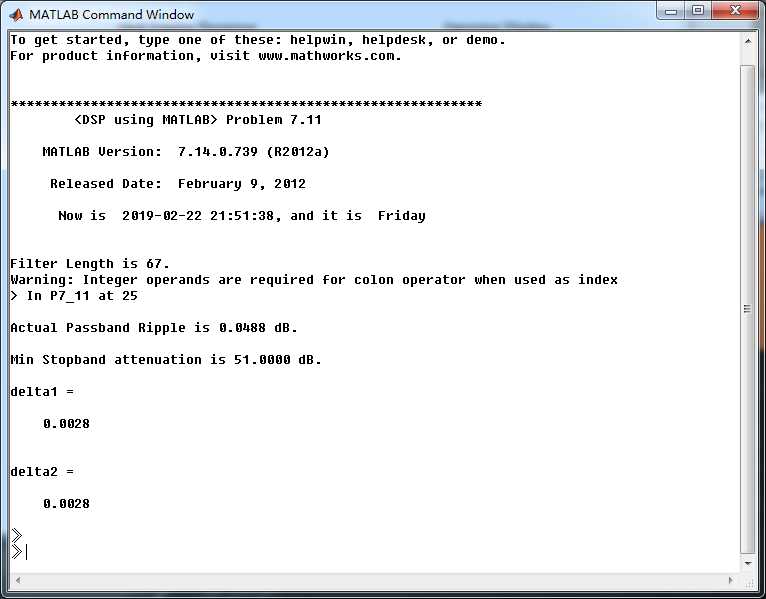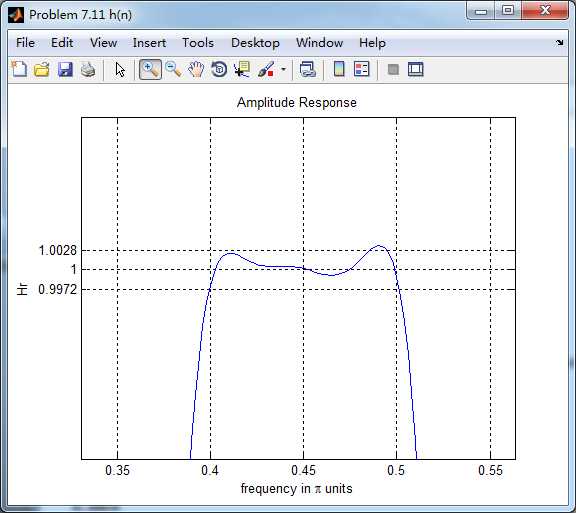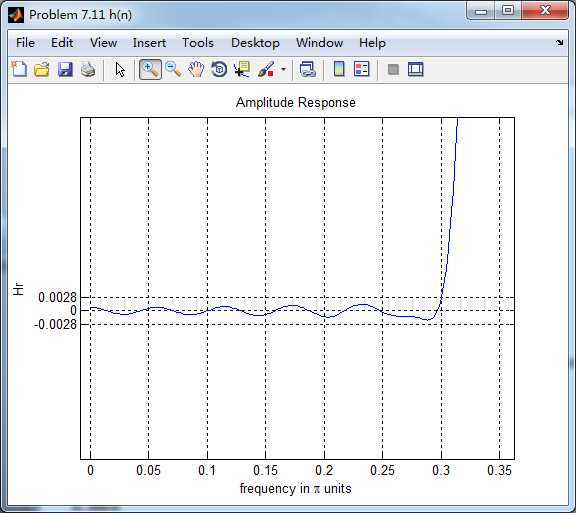《DSP using MATLAB》Problem 7.11
Posted ky027wh-sx
tags:
篇首语:本文由小常识网(cha138.com)小编为大家整理,主要介绍了《DSP using MATLAB》Problem 7.11相关的知识,希望对你有一定的参考价值。

代码:
%% ++++++++++++++++++++++++++++++++++++++++++++++++++++++++++++++++++++++++++++++++ %% Output Info about this m-file fprintf(‘ *********************************************************** ‘); fprintf(‘ <DSP using MATLAB> Problem 7.11 ‘); banner(); %% ++++++++++++++++++++++++++++++++++++++++++++++++++++++++++++++++++++++++++++++++ % bandpass ws1 = 0.3*pi; wp1 = 0.4*pi; wp2 = 0.5*pi; ws2 = 0.6*pi; As = 50; Rp = 0.5; tr_width = min((wp1-ws1), (ws2-wp2)); M = ceil(6.6*pi/tr_width) + 1; % Hamming Window fprintf(‘ Filter Length is %d. ‘, M); n = [0:1:M-1]; wc1 = (ws1+wp1)/2; wc2 = (wp2+ws2)/2; %wc = (ws + wp)/2, % ideal LPF cutoff frequency hd = ideal_lp(wc2, M) - ideal_lp(wc1, M); w_hamm = (hamming(M))‘; h = hd .* w_hamm; [db, mag, pha, grd, w] = freqz_m(h, [1]); delta_w = 2*pi/1000; [Hr,ww,P,L] = ampl_res(h); Rp = -(min(db(wp1/delta_w+1 :1: wp2/delta_w))); % Actual Passband Ripple fprintf(‘ Actual Passband Ripple is %.4f dB. ‘, Rp); As = -round(max(db(ws2/delta_w+1 : 1 : 501))); % Min Stopband attenuation fprintf(‘ Min Stopband attenuation is %.4f dB. ‘, As); [delta1, delta2] = db2delta(Rp, As) % Plot figure(‘NumberTitle‘, ‘off‘, ‘Name‘, ‘Problem 7.11 ideal_lp Method‘) set(gcf,‘Color‘,‘white‘); subplot(2,2,1); stem(n, hd); axis([0 M-1 -0.3 0.3]); grid on; xlabel(‘n‘); ylabel(‘hd(n)‘); title(‘Ideal Impulse Response‘); subplot(2,2,2); stem(n, w_hamm); axis([0 M-1 0 1.1]); grid on; xlabel(‘n‘); ylabel(‘w(n)‘); title(‘Hamming Window‘); subplot(2,2,3); stem(n, h); axis([0 M-1 -0.3 0.3]); grid on; xlabel(‘n‘); ylabel(‘h(n)‘); title(‘Actual Impulse Response‘); subplot(2,2,4); plot(w/pi, db); axis([0 1 -100 10]); grid on; set(gca,‘YTickMode‘,‘manual‘,‘YTick‘,[-90,-51,0]); set(gca,‘YTickLabelMode‘,‘manual‘,‘YTickLabel‘,[‘90‘;‘51‘;‘ 0‘]); set(gca,‘XTickMode‘,‘manual‘,‘XTick‘,[0,0.3,0.4,0.5,0.6,1]); xlabel(‘frequency in pi units‘); ylabel(‘Decibels‘); title(‘Magnitude Response in dB‘); figure(‘NumberTitle‘, ‘off‘, ‘Name‘, ‘Problem 7.11 h(n) ideal_lp Method‘) set(gcf,‘Color‘,‘white‘); subplot(2,2,1); plot(w/pi, db); grid on; %axis([0 1 -100 10]); xlabel(‘frequency in pi units‘); ylabel(‘Decibels‘); title(‘Magnitude Response in dB‘); set(gca,‘YTickMode‘,‘manual‘,‘YTick‘,[-90,-51,0]) set(gca,‘YTickLabelMode‘,‘manual‘,‘YTickLabel‘,[‘90‘;‘51‘;‘ 0‘]); set(gca,‘XTickMode‘,‘manual‘,‘XTick‘,[0,0.3,0.4,0.5,0.6,1,1.4,1.5,1.6,1.7,2]); subplot(2,2,3); plot(w/pi, mag); grid on; %axis([0 1 -100 10]); xlabel(‘frequency in pi units‘); ylabel(‘Absolute‘); title(‘Magnitude Response in absolute‘); set(gca,‘XTickMode‘,‘manual‘,‘XTick‘,[0,0.3,0.4,0.5,0.6,1,1.4,1.5,1.6,1.7,2]); set(gca,‘YTickMode‘,‘manual‘,‘YTick‘,[0.0,0.5,1.0]) subplot(2,2,2); plot(w/pi, pha); grid on; %axis([0 1 -100 10]); xlabel(‘frequency in pi units‘); ylabel(‘Rad‘); title(‘Phase Response in Radians‘); subplot(2,2,4); plot(w/pi, grd*pi/180); grid on; %axis([0 1 -100 10]); xlabel(‘frequency in pi units‘); ylabel(‘Rad‘); title(‘Group Delay‘); figure(‘NumberTitle‘, ‘off‘, ‘Name‘, ‘Problem 7.11 h(n)‘) set(gcf,‘Color‘,‘white‘); plot(ww/pi, Hr); grid on; %axis([0 1 -100 10]); xlabel(‘frequency in pi units‘); ylabel(‘Hr‘); title(‘Amplitude Response‘); set(gca,‘YTickMode‘,‘manual‘,‘YTick‘,[-delta2,0,delta2,1 - delta1,1, 1 + delta1]) %set(gca,‘YTickLabelMode‘,‘manual‘,‘YTickLabel‘,[‘90‘;‘45‘;‘ 0‘]); %set(gca,‘XTickMode‘,‘manual‘,‘XTick‘,[0,0.2,0.35,0.55,0.75,1,1.2,1.55,2]);
运行结果:
阻带最小衰减51dB,满足设计要求。

Hamming窗截断的滤波器脉冲响应,其幅度响应(dB和Absolute单位)、相位响应和群延迟


振幅响应

带通部分

阻带部分

以上是关于《DSP using MATLAB》Problem 7.11的主要内容,如果未能解决你的问题,请参考以下文章